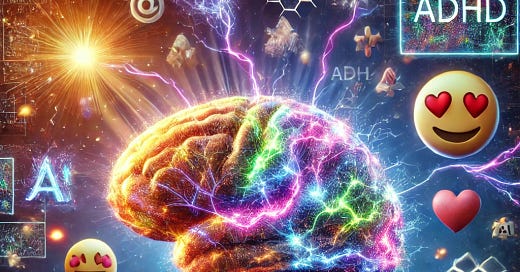AI-Generated Fiction: Through the ADHD Lens
How neurodivergent minds decode the strange brilliance—and emotional weight—of AI-generated stories.
Is that AI-generated story from Sam Altman's "new model" brilliant or terrible? The answer might depend on how your brain processes information.
As someone with ADHD, I found myself oddly captivated by the story Jennifer Walshe describes in her analysis. Not because the story itself was particularly good (it sounds pretty mid, honestly), but because of the fascinating way she dissects it - looking for the "texture" of AI writing, the "frayed joins" and "unnaturally smooth sections."
Your Brain on AI Content
When you have ADHD, you're often hyper-aware of patterns others might miss. The dopamine-seeking brain excels at making connections, noticing inconsistencies, and picking up on subtleties that neurotypical readers might gloss over. This makes us uniquely positioned to develop what Walshe calls a "new type of literacy" for AI content.
Think about it:
We naturally look for the weird edges in content
We're sensitive to tone shifts that don't quite fit
We catch repetitive patterns quickly (hello, "ending every paragraph with a line seemingly designed to feature on the Kindle Store")
Recent research on ADHD and pattern recognition supports this. A 2023 study from the University of Cambridge found that ADHD brains often excel at detecting statistical irregularities in complex stimuli - exactly what you need to spot the "extra fingers" of AI-generated content.
The Emotional Labor Behind AI Stories
The most thought-provoking part of Walshe's analysis is her connection between AI writing and emotional labor. When she unpacks the name "Mila" and connects it to thousands of social media posts about babies - including those who died - she highlights something profound about what AI systems are actually doing.
They're not creating. They're remixing our collective grief, joy, and experiences without attribution or consent.
For those of us with ADHD who often feel emotions intensely, this hits differently. Our own emotional experiences might be part of what trained these models. That poem you wrote during your darkest depression? That celebratory post about finally accomplishing something despite executive dysfunction? All potentially training fodder.
Reading Between the Lines (An ADHD Superpower)
Here's where our ADHD brains have an advantage. We're naturally inclined toward:
Divergent thinking - we make unexpected connections between ideas
Hyperfocus - we can dive deep into analyzing something interesting
Pattern recognition - we notice repetition and formulas
These traits position us to be excellent critical readers of AI content. We can see both the interesting creative potential AND the concerning implications simultaneously.
Moving Beyond Binaries
The reactions to Altman's AI story fell into predictable camps: tech bros loved it, writers hated it, and everyone else wanted the TL;DR. But that binary thinking misses what's actually happening.
AI writing isn't going to replace human writers entirely, but it is changing the landscape in ways we need to understand. For those with ADHD who navigate between hyperfocus and distractibility, we already understand what it means to have a complex, non-binary relationship with information.
Developing Your AI Literacy
Want to build your own AI literacy skills? Try these approaches:
Look for repetitive sentence structures or phrases
Notice when emotional descriptions feel generic
Pay attention to how specific details are handled
Consider who benefits from the content's creation
The next time you encounter AI-generated content, approach it with curiosity rather than immediate judgment. What does it tell you about how machines process information? What does your reaction tell you about how YOU process information?
As AI content becomes increasingly prevalent, our ability to read critically becomes more important than ever. And for those with ADHD, our neurodivergent perspectives might just be the perfect lens through which to understand this new world of machine-generated creativity.
What do you think? How does your brain process AI content differently? Drop your thoughts in the comments below.



